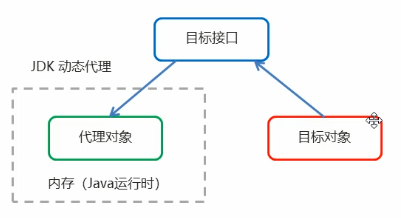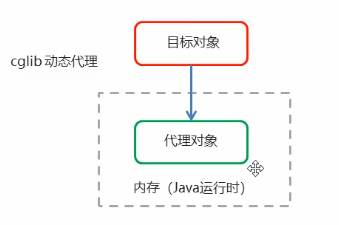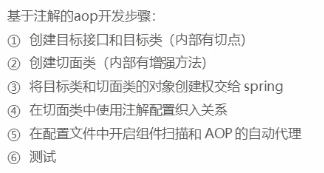AOP introduction
Role and advantages of aop
Function: during the running of the program, enhance the function of the method without modifying the source code
(vernacular): dynamic code enhancement
Advantages: reduce duplicate code, improve development efficiency, and easy to maintain
(vernacular): it's easy to use
aop underlying implementation
The lower layer of AOP is realized through the dynamic proxy technology provided by Spring.
Spring dynamically generates proxy objects through dynamic proxy technology. When the proxy method is executed, it intervenes to call the methods of the target object to complete the function enhancement.
Dynamic agent based on JDK (as follows)

Target method interface
public interface TargetInterface {
public void save();
}
Target method realization
public class Target implements TargetInterface {
@Override
public void save() {
System.out.println("save running......");
}
}
Enhancement method
public class Advice {
public void before(){
System.out.println("Pre enhancement...");
}
public void afterReturning(){
System.out.println("Post enhancement...");
}
}
test
public class ProxyTest {
public static void main(String[] args) {
//Create target object
Target target = new Target();
//Create enhancement object
Advice advice =new Advice();
TargetInterface proxy = (TargetInterface) Proxy.newProxyInstance(
target.getClass().getClassLoader(),
target.getClass().getInterfaces(),
new InvocationHandler() {
@Override
public Object invoke(Object proxy, Method method, Object[] args) throws Throwable {
advice.before();
method.invoke(target, args);
advice.afterReturning();
return null;
}
});
proxy.save();
}
}
Dynamic agent based on cglib

Target method
public class Target {
public void save() {
System.out.println("save running......");
}
}
Enhancement method
public class Advice {
public void before(){
System.out.println("Pre enhancement...");
}
public void afterReturning(){
System.out.println("Post enhancement...");
}
}
test
public class ProxyTest {
public static void main(String[] args) {
//Create target object
Target target = new Target();
//Create enhancement object
Advice advice =new Advice();
Enhancer enhancer = new Enhancer();
enhancer.setSuperclass(Target.class);
enhancer.setCallback(new MethodInterceptor() {
@Override
public Object intercept(Object o, Method method, Object[] objects, MethodProxy methodProxy) throws Throwable {
advice.before();
Object invoke = method.invoke(target, args);
advice.afterReturning();
return invoke;
}
});
Target proxy = (Target) enhancer.create();
proxy.save();
}
}
Implementing aop with xml

① Import coordinates
<!-- https://mvnrepository.com/artifact/org.springframework/spring-context -->
<dependency>
<groupId>org.springframework</groupId>
<artifactId>spring-context</artifactId>
<version>5.3.8</version>
</dependency>
<dependency>
<groupId>org.aspectj</groupId>
<artifactId>aspectjweaver</artifactId>
<version>1.8.4</version>
</dependency>
<!-- https://mvnrepository.com/artifact/junit/junit -->
<dependency>
<groupId>org.springframework</groupId>
<artifactId>spring-test</artifactId>
<version>5.3.
② Create target interface and target class
Target interface
public interface TargetInterface { public void save();}
Goal realization class
public class Target implements TargetInterface { @Override public void save() { System.out.println("save running......"); }}
③ Create facet class (enhancement method class)
public class MyAspect { public void before(){ System.out.println("Pre enhancement...."); } public void afterReturning(){ System.out.println("Post enhancement..."); }}
④ Spring management
1. Create ApplicationContext xml
‖. Leave the object to Spring management
<!--Target object--> <bean id="target" class="link.zishu.aop.Target"/><!--Tangent object--><bean id="myAspect" class="link.zishu.aop.MyAspect"/>
⑤ Configure the weaving relationship in the configuration file
<!--Configuration weaving, tell spring frame,What methods(Tangent point)What enhancements are needed(Front,Post enhancement)--> <aop:config> <!--Declaration section--> <aop:aspect ref="myAspect"> <!--section= Tangent point + notice--> <!--pointcut="execution(public void link.zishu.aop.Target.save())"/>--> <aop:before method="before" pointcut="execution( * link.zishu.aop.Target.save())"/> <aop:after-returning method="afterReturning" pointcut="execution(* link.zishu.aop.Target.save())"/> </aop:aspect> </aop:config>
⑥ Testing
@RunWith(SpringJUnit4ClassRunner.class)@ContextConfiguration("classpath:applicationContext.xml")
public class AopTest {
@Autowired
private TargetInterface target;
@Test
public void Test1(){
target.save();
}
}
Implementing aop with annotations

① Create target interface and target class
Target interface
public interface TargetInterface { public void save();}
Goal realization class
public class Target implements TargetInterface { @Override public void save() { System.out.println("save running......"); }}
② Create facet class (enhancement method class)
public class MyAspect { public void before(){ System.out.println("Pre enhancement...."); } public void afterReturning(){ System.out.println("Post enhancement..."); }}
③ Spring management
Through the Component annotation, it is handed over to Spring for management


④ Using annotations to configure weaving relationships in facet classes
Different enhancements are configured through different annotations. For example: pre enhancement @ Before post enhancement @ AfterReturning
@Before("execution(* link.zishu.anno.Target.save())")
public void before(){
System.out.println("Pre enhancement....");
}
⑤ Turn on the automatic agent for component scanning and AOP in the configuration file
<!--Enable annotation scanning --> <context:component-scan base-package="link.zishu.anno"/> <!--aop Automatic proxy for--> <aop:aspectj-autoproxy />
⑥ Testing
@RunWith(SpringJUnit4ClassRunner.class)@ContextConfiguration("classpath:applicationContext-anno.xml")
public class AnnoTest {
@Autowired
private TargetInterface target;
@Test
public void Test1(){
target.save();
}
}
Enhanced classification
| Method name | Method name | explain |
|---|---|---|
| Before advice | @Before | Notify before calling method |
| Post notification | @After-returning | Notification after method invocation (when method execution is successful) |
| Around Advice | @Around | Some customized operations before and after method call |
| Exception notification | @After-throwing | Notify after calling a method (when the method throws an exception) |
| Final notice | @After | Notification after a method is called, regardless of the method execution state |